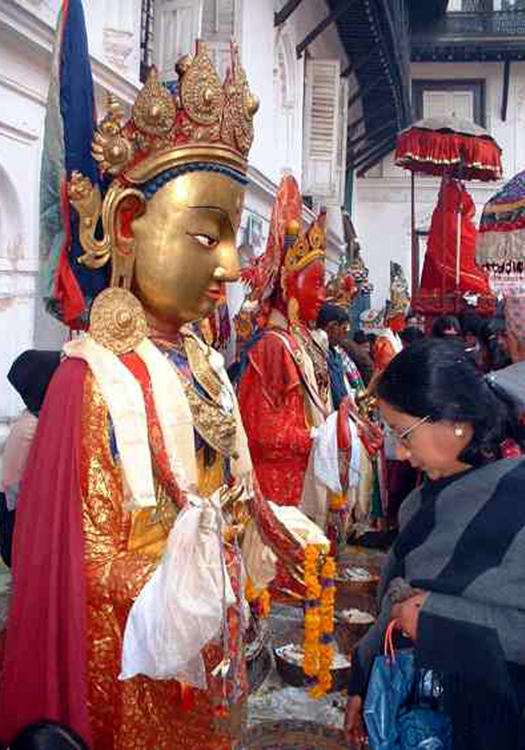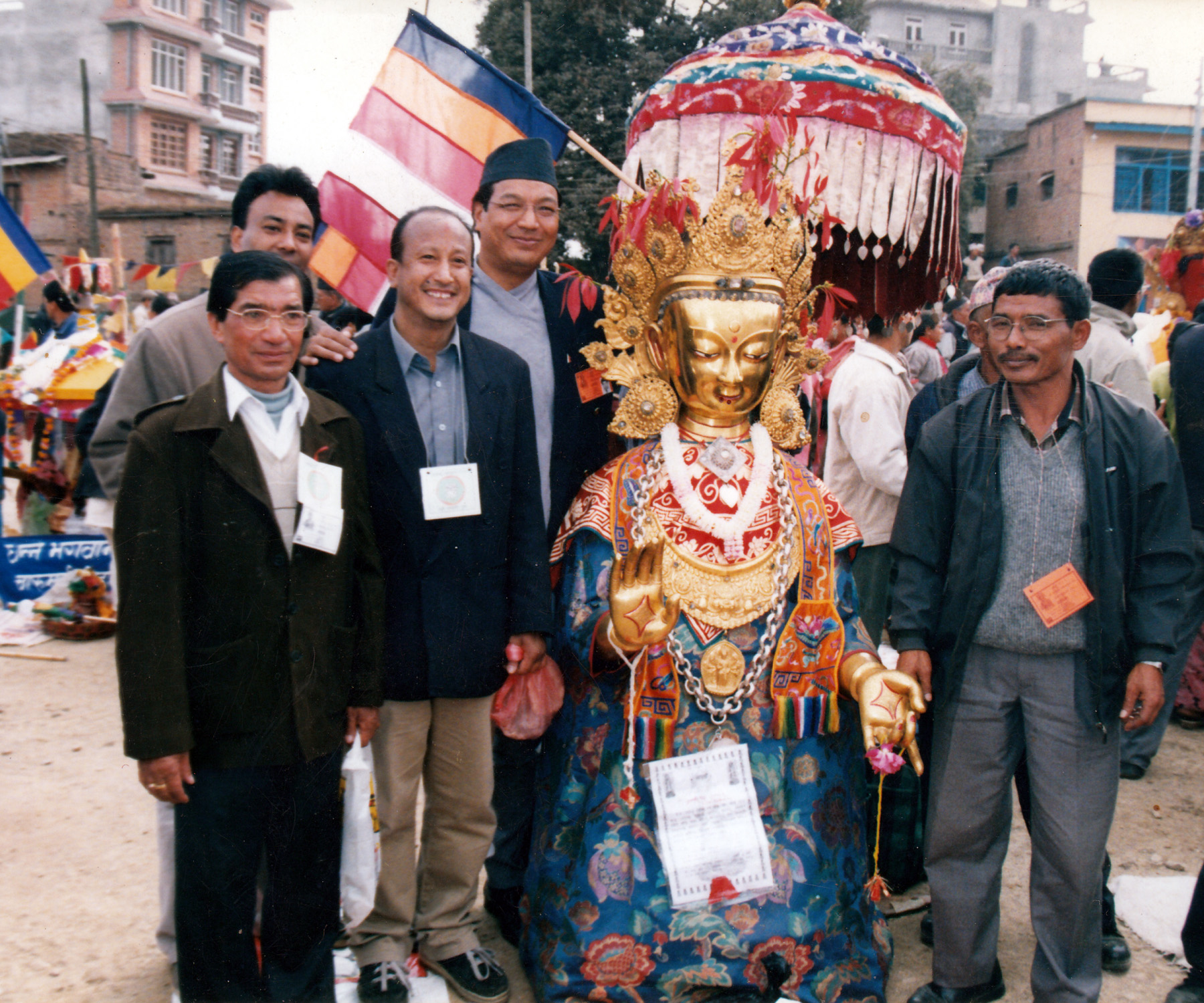|
Bhuikhel
Bhuikhel ( ne, भुइखेल) is a large plain located in the western part of Kathmandu at the foot of Swayambhu hill. Also known as Bhukhel (भुखेल), it is famed for the Buddhist Samyak festival held here. The field is one of the city's landmarks and the hallowed venue of Samyak, a spectacular celebration when hundreds of images of Dīpankara Buddha are assembled for an alms-giving ceremony. Bhuikhel's area has shrunk over the years due to construction on its edges. Religious significance Bhuikhel is of sacred significance because it is the site of the Samyak ceremony of Kathmandu. This alms-giving festival is held in all the three cities of the Kathmandu Valley at differing intervals. In Bhaktapur, Samyak is celebrated annually, in Patan Patan may refer to several places in Afghanistan, India and Nepal: Afghanistan *Patan, Afghanistan India * Patan district, in the state of Gujarat * Patan, Gujarat, the main city of the eponymous district * Patan was t ... [...More Info...] [...Related Items...] OR: [Wikipedia] [Google] [Baidu] |
Samyak 2002
Samyak ( ne, सम्यक) is an almsgiving Buddhist festival celebrated in the Kathmandu Valley in Nepal. During the ceremony which is held on a large open ground, hundreds of Dīpankara Buddha images are assembled, and gifts of different types of food are made to the Buddha images and the Buddhist community. Samyak is the most spectacular Newar Buddhist celebration. It is observed at different intervals in the three cities of the valley -- every 12 years in Kathmandu, every five years in Lalitpur and annually in Bhaktapur. The first documented Samyak festival in Kathmandu took place in 1015 AD (135 Nepal Era). The festival brings together a wide cross-section of Newar society, including priests, artisans, traders, musicians and farmers. Each group has a defined role designed to highlight social harmony. The ceremony celebrates the practice of giving to the Buddhas and monks in the Newar Buddhist tradition. The Samyak festival in Kathmandu is held at Kathmandu Durba ... [...More Info...] [...Related Items...] OR: [Wikipedia] [Google] [Baidu] |
Samyak
Samyak ( ne, सम्यक) is an almsgiving Buddhist festival celebrated in the Kathmandu Valley in Nepal. During the ceremony which is held on a large open ground, hundreds of Dīpankara Buddha images are assembled, and gifts of different types of food are made to the Buddha images and the Buddhist community. Samyak is the most spectacular Newar Buddhist celebration. It is observed at different intervals in the three cities of the valley -- every 12 years in Kathmandu, every five years in Lalitpur and annually in Bhaktapur. The first documented Samyak festival in Kathmandu took place in 1015 AD (135 Nepal Era). The festival brings together a wide cross-section of Newar society, including priests, artisans, traders, musicians and farmers. Each group has a defined role designed to highlight social harmony. The ceremony celebrates the practice of giving to the Buddhas and monks in the Newar Buddhist tradition. The Samyak festival in Kathmandu is held at Kathmandu Durbar S ... [...More Info...] [...Related Items...] OR: [Wikipedia] [Google] [Baidu] |
Kathmandu
, pushpin_map = Nepal Bagmati Province#Nepal#Asia , coordinates = , subdivision_type = Country , subdivision_name = , subdivision_type1 = Provinces of Nepal, Province , subdivision_name1 = Bagmati Province , subdivision_type2 = List of districts of Nepal, District , subdivision_name2 = Kathmandu District, Kathmandu , established_title = , founder = Manjushri , parts_type = No. of Ward (electoral subdivision), Wards , parts = 32 , seat_type = , seat = , government_footnotes = , government_type = Mayor–council government , governing_body = Kathmandu Metropolitan Government, , leader_title = Mayor of Kathmandu, Mayor , leader_name = Balendra Shah (Independent politician, Ind.) , leader_title1 = Deputy mayor , leader_name1 = Su ... [...More Info...] [...Related Items...] OR: [Wikipedia] [Google] [Baidu] |
Swayambhunath
Swayambhu (Devanagari: स्वयम्भू स्तूप; new, स्वयंभू; sometimes Swayambu or Swoyambhu) is an ancient religious complex atop a hill in the Kathmandu Valley, west of Kathmandu city. The Tibetan name for the site means 'Sublime Trees' ( Wylie: ''Phags.pa Shing.kun''), for the many varieties of trees found on the hill. However, ''Shingkun'' may be of the local in Tamang Bhasa name for the complex, Swayambhu, meaning 'self-sprung'. For the Buddhist Newars, in whose mythological history and origin myth as well as day-to-day religious practice Swayambhunath occupies a central position, it is probably the most sacred among Buddhist pilgrimage sites. For Tibetans and followers of Tibetan Buddhism, it is second only to Boudha. Swayambhunath is the Hindu name. The complex consists of a stupa, a variety of shrines and temples, some dating back to the Licchavi period. A Tibetan monastery, museum and library are more recent additions. The stupa has ... [...More Info...] [...Related Items...] OR: [Wikipedia] [Google] [Baidu] |
Buddhist
Buddhism ( , ), also known as Buddha Dharma and Dharmavinaya (), is an Indian religion or philosophical tradition based on teachings attributed to the Buddha. It originated in northern India as a -movement in the 5th century BCE, and gradually spread throughout much of Asia via the Silk Road. It is the world's fourth-largest religion, with over 520 million followers (Buddhists) who comprise seven percent of the global population. The Buddha taught the Middle Way, a path of spiritual development that avoids both extreme asceticism and hedonism. It aims at liberation from clinging and craving to things which are impermanent (), incapable of satisfying ('), and without a lasting essence (), ending the cycle of death and rebirth (). A summary of this path is expressed in the Noble Eightfold Path, a training of the mind with observance of Buddhist ethics and meditation. Other widely observed practices include: monasticism; "taking refuge" in the Buddha, the , and the ... [...More Info...] [...Related Items...] OR: [Wikipedia] [Google] [Baidu] |
Dīpankara Buddha
Dipankara (Pali: ''Dīpaṅkara''; Sanskrit: ', "Lamp bearer") or Dipankara Buddha is one of the Buddhas of the past. He is said to have lived on Earth four asankheyyas and one hundred thousand kappas ago. According to some Buddhist or folk traditions, Dipankara was a previous Buddha who attained Enlightenment eons prior to Gautama Buddha, the historical Buddha. Generally, Buddhists believe that there has been a succession of many Buddhas in the distant past and that many more will appear in the future. Dipankara was one of these previous Buddhas, while Gautama Buddha was the current and most recent Enlightened one, and Maitreya will be the next Buddha in the distant future. Chinese Buddhism honors Dipankara as one of many Buddhas of the past. Dipankara, Gautama, and Maitreya are "the Buddhas of Three Times" in Yiguandao. Iconography Dipankara is generally represented as a sitting Buddha, but his depictions as a standing Buddha are common in China, Thailand, and Nepal; wi ... [...More Info...] [...Related Items...] OR: [Wikipedia] [Google] [Baidu] |
Kathmandu Valley
The Kathmandu Valley ( ne, काठमाडौं उपत्यका; also known as the Nepal Valley or Nepa Valley ( ne, नेपाः उपत्यका, Nepal Bhasa: 𑐣𑐾𑐥𑐵𑑅 𑐐𑐵𑑅, नेपाः गाः)), is a bowl-shaped valley located in the Himalayan mountains in Nepal. It lies at the crossroads of ancient civilizations of the Indian subcontinent and the broader Asian continent, and has at least 130 important monuments, including several pilgrimage sites for Hindus and Buddhists. There are seven World Heritage Sites within the valley. The Kathmandu Valley is the most developed and the largest urban agglomeration in Nepal with about 5 million population. The urban agglomeration of Kathmandu Valley includes the cities of Kathmandu, Lalitpur, Budhanilkantha, Tarakeshwar, Gokarneshwar, Suryabinayak, Tokha, Kirtipur, Madhyapur Thimi, Bhaktapur, etc. The majority of offices and headquarters are located in the valley, making it the ... [...More Info...] [...Related Items...] OR: [Wikipedia] [Google] [Baidu] |
Patan, Nepal
Lalitpur Metropolitan City, historically Patan ( sa, पाटन ''Pāṭana'', Nepal bhasa : '' Yela'', ), is the fourth most populous city of Nepal after Kathmandu, Pokhara and Bharatpur, and it is located in the south-central part of Kathmandu Valley, a new metropolitan city of Nepal. Lalitpur is also known as Manigal. It is best known for its rich cultural heritage, particularly its tradition of arts and crafts. It is city renowned for its festival and feast, fine ancient art, and the making of metallic, wood and stone carved statues. At the time of the 2011 Nepal census it had a population of 226,728 in 54,748 individual households. The city received extensive damage from an earthquake on 25 April 2015. Geography Lalitpur is on the elevated tract of land in Kathmandu Valley on the south side of the Bagmati River, which separates it from the city of Kathmandu on the northern and western side. The Karmanasa Khola acts as the boundary on the eastern side. It was develo ... [...More Info...] [...Related Items...] OR: [Wikipedia] [Google] [Baidu] |
Kathmandu Durbar Square
Kathmandu Durbar Square (''Basantapur Durbar Kshetra'') is located in front of the old royal palace of the former Kathmandu Kingdom and is one of three Durbar (royal palace) Squares in the Kathmandu Valley in Nepal, all of which are UNESCO World Heritage Sites. Several buildings in the square collapsed due to a major earthquake on 25 April 2015. Durbar Square was surrounded with spectacular architecture and vividly showcases the skills of the Newar artists and craftsmen over several centuries. The Royal Palace was originally at Dattaraya square and was later moved to the Durbar square.Nepal Handbook by Tom Woodhatch The Kathmandu Durbar Square held the palaces of the Malla and Shah kings who ruled over the city. Along with these palaces, the square surrounds quadrangles, revealing courtyards and temples. It is known as Hanuman Dhoka Durbar Square, a name derived from a statue of Hanuman, the monkey devotee of Lord Ram, at the entrance of the palace. History and constr ... [...More Info...] [...Related Items...] OR: [Wikipedia] [Google] [Baidu] |
William Kirkpatrick (East India Company Officer)
William Kirkpatrick (1754–1812) was an East India Company officer, diplomat and orientalist active in Colonial India during the period of Company rule. Life He was the eldest son of Colonel James Kirkpatrick, Madras army, and grandson of James Kirkpatrick, M.D. the author. His father was in command of the troops at Fort Marlborough, Sumatra, in 1777, and returned home in 1779. He married Katherine, daughter of Alexander Monro, by whom he had three sons—William, George, in the Bombay civil service, and James Achilles. He died at Hollydale, Kent, in 1818, aged 89. William Kirkpatrick, the eldest son, became a cadet in 1771, was appointed ensign in the Bengal infantry on 17 January 1773, lieutenant 9 April 1777, captain 3 April 1781, and major 1 March 1794. He was Persian interpreter to Giles Stibbert, who was commander-in-chief in Bengal in 1777–9 and 1780–5, and prepared a Persian translation of the articles of war (printed 1782). Afterwards he was resident with Mahad ... [...More Info...] [...Related Items...] OR: [Wikipedia] [Google] [Baidu] |
Charles Cornwallis
Charles Cornwallis, 1st Marquess Cornwallis, (31 December 1738 – 5 October 1805), styled Viscount Brome between 1753 and 1762 and known as the Earl Cornwallis between 1762 and 1792, was a British Army general and official. In the United States and the United Kingdom, he is best remembered as one of the leading British generals in the American War of Independence. His surrender in 1781 to a combined American and French force at the siege of Yorktown ended significant hostilities in North America. He later served as a civil and military governor in Ireland, where he helped bring about the Act of Union; and in India, where he helped enact the Cornwallis Code and the Permanent Settlement. Born into an aristocratic family and educated at Eton and Cambridge, Cornwallis joined the army in 1757, seeing action in the Seven Years' War. Upon his father's death in 1762 he became Earl Cornwallis and entered the House of Lords. From 1766 until 1805 he was Colonel of the 33rd Regim ... [...More Info...] [...Related Items...] OR: [Wikipedia] [Google] [Baidu] |









